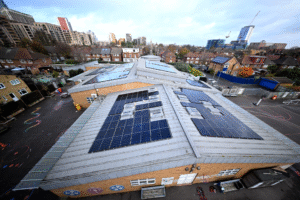Temperatures are rising everywhere from geopolitics to the Southern Ocean. As we enter a ‘pivotal five years’ in the fight to halt the environmental crisis, we throw caution into the storm and money behind seven expert predictions.
If 2024 taught us anything, it’s that momentum seems to be on the wrong side of humanity. Over a 12 month period, we saw world leaders shirk their responsibility to follow up on promises of a decarbonisation roadmap, thermometers soar to the Hottest Year On Record, AI boom despite the catastrophic climate impact, and talk of the unimaginable – World War III, even nuclear bombs – eclipse the doom we know is inevitable without a serious ecological rethink.
Things culminated in a COP summit that may have sounded the death knell for the legitimacy of future summits, and the success of notorious global heating denier Donald Trump in the US presidential election, ushering in yet more distractions and uncertainty. So it’s easy to understand the malaise, mistrust and misty-eyed reflections dominating public discourse.
Thankfully, some analysts have been able to see through the fear, rage, disbelief and depression long enough to come up with some educated guesses as to what 2025 will bring in terms of climate, nature, and net zero. Having scoured for the most insightful, inspiring and important, here are eight things every environmental professional can expect from the newborn year.
Finance for net zero transition will be the biggest local concern
Mitie’s Net Zero Navigator report for 2025 reveals overall optimism among ‘sustainability leaders’ that businesses can align with government-mandated targets on energy and emissions. However, it also tells us 78% of corporate decision-makers are finding it difficult to secure capital to switch away from fossil fuels. Meanwhile, availability and reliability of renewable power remains another major concern. Simply put, cheaper, rapidly deployable solutions will be in high demand everywhere from the grid itself to commercial customers to meet localised needs.
The Paris Agreement will (finally) fail
News to few, the Verdantix Net Zero & Climate Risk report predicts the ‘official fall’ of the Paris Agreement in 2025 as desperate hopes of limiting global warming to 1.5C above pre-industrial levels disappear. But this doesn’t mean abandoning decarbonisation and cooling policies. As Southern California’s winter bursts into flames, an omen of yet another searingly hot year ahead and a window onto a future that’s literally on fire, expect national climate goals to reflect an unfortunate but inevitable rethink about what constitutes a realistic target.
Nationally Determined Contributions will be updated
Also known as climate action plans, 2025 is the deadline for the latest iterations of Nationally Determined Contributions to be published under the Paris Agreement. According to Dutch Minister for Environment & Housing/, Stientje van Veldhoven, the dominant trend will be for ‘integration of climate and nature’ policies, reflecting increasing acknowledgement of how interlinked systems are. Commitments will also be more concrete as time pressures mount for delivery of tangible results.
Global oil demand will rise (but not because of cars)
Air passenger numbers are already above pre-COVID-19 levels, military conflicts guzzling vast amounts of gas right now, and India has slowed its net zero rollout. These are just a few reasons demand for fossil fuels is so high, although Wood Mackenzie reports petrochemical feedstocks are a key driver, rather than transport fuels. Using China as a prime example, many countries are now seeing EVs and LNG-powered vehicles take a big bite out of their diesel and petrol consumption, which is essential to support emissions reductions on a global scale.
Carbon offsets will make a comeback
Offsetting carbon emissions often invokes stories of greenwashing, fraud, corruption, and companies marking their own homework. Nevertheless, rules around legitimate carbon market trading are becoming tighter. And there’s a clear need for a concrete, regulated system allowing corporations and countries to gradually reduce negative impacts while rapidly increasing their positive environmental contributions. This means efforts to strengthen safeguards and securities at policy level, domestically, regionally, and globally, will become a priority, according to energy journal EVWind.
Circularity will become integral to operations
Reuse and recycling are fundamental cornerstones of sustainability – we need to produce and consume less in order to tackle the twin threats of climate change and pollution. Major brands, many with questionable environmental records themselves – like resource hungry fast food and fashion giants McDonalds and H&M – are finally embracing what this really means. For example, by turning waste cooking oil into biodiesel for deliveries and calling for circularity standards across the textile industry. University of Salford academics expect this momentum will increase as 2025 unfolds.
Active travel investment will deliver tangible results
Public spending on cycling, wheeling and walking infrastructure has proven to be the source of significant division in many UK towns and cities. Highly disruptive, widespread construction work has been underway since the pandemic in a bid to introduce more robust active travel routes through urban areas – following London’s more established model. Today, the capital has proven supply of quality bicycle lanes and similar leads to an uptick in demand. Having spent the past four years digging up trunk roads to encourage pedal powered commutes, regional hubs should start to see the fruits of that expenditure, or face another bout of questions and criticism.
More features, case studies and industry insight:
The biggest local authority climate and environment stories of 2024
Your footprint here: digital advertising emissions and how to reduce them
Image: Ines Cvitić via Unsplash

















